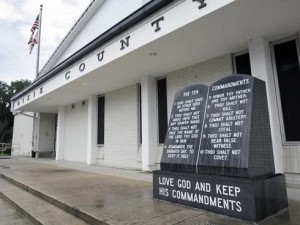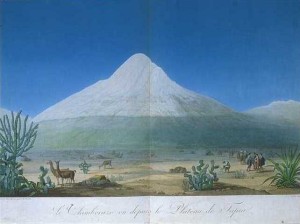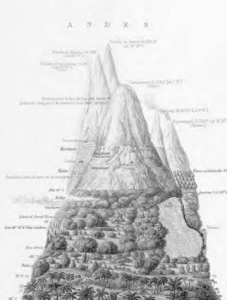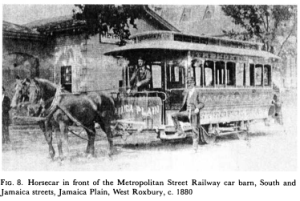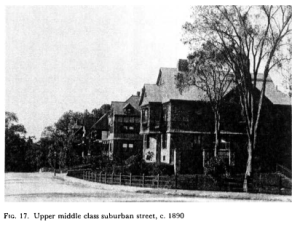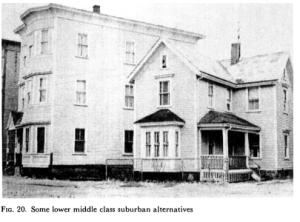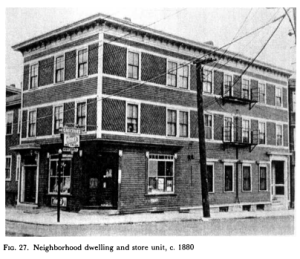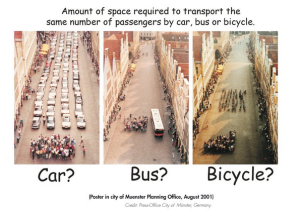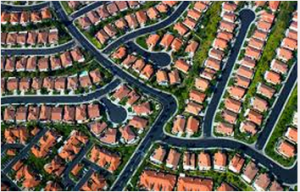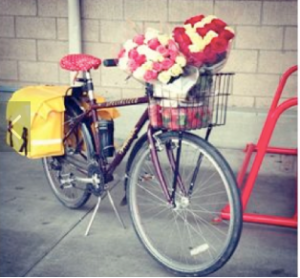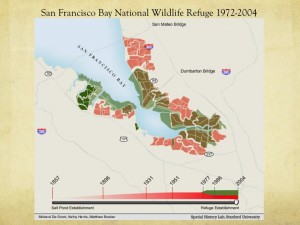While this year’s news seems to show the modern American conservative strategies seeming to unravel, I recently read two books by Kevin Kruse showing the origins of those strategies. White Flight shows the origins of low-tax, privatized, drown-the-government-in-the-bathtub platform in the racial politics of metro Atlanta. One Nation Under God focuses on the origins of the alliance between big business and the religious right.
In the post-WW2 era, Atlanta marketed itself as “the city too busy to hate” but behind the scenes, Atlanta neighborhoods were torn by racial strife. Black residents were confined to a limited number of over-crowded and rundown neighborhoods, and those with the means sought more space and better living conditions. After residential segregation was struck down by the courts, local customs maintained segregation.
White residents pledged not to sell to black people, and real estate agents were bound by their code of “ethics” not to sell from white to black. If a few black people moved into a white area, the locals resisted, often with violence. Then, real estate sales people took advantage of white fear of black neighbors to encourage rapid migration, where the neighborhood shifted rapidly from all-white to all-black. To block change, city leaders took steps such as routing freeways and expressways between black and white neighborhoods, and zoning for industrial uses between white and black areas, but these tactics did not work for long. Kruse tells these stories with rich and plentiful detail as the patterns repeated in neighborhood after neighborhood.
Over time, the political rhetoric of white residents fighting change shifted. Earlier on, opponents to change were explicitly racist, with participation from Ku Klux Klan and other white supremacist groups, and overtly terrorist tactics. Later on, whites fighting change moderated the rhetoric, and portrayed their opposition to sharing space with black people in terms of American values “freedom of association” and “free enterprise”. The message of “free enterprise” played a stronger role after civil rights protests to integrate hotels and restaurants broke down the traditional alliance between the white business establishment and black leaders who collaborated to promote peaceful prosperity at the cost of acceptance of segregation.
The concepts of integrated neighborhoods and integrated public facilities were inconceivable for white residents who bitterly resented the loss of “their” parks, swimming pools, public golf courses and libraries. Rather than sharing facilities, or “wasting” public funds on black “intruders”, white leaders choose to set up separate, private, segregated facilities, and often to close or de-fund the facilities now used by black people.
The more “moderate” and “reasonable” messages of freedom of assembly and free enterprise helped leaders with these messages start to win elections and gain political power. The strategy of privatization became easier as white residents increasingly moved outside city boundaries to suburbs. These suburban communities nurtured new generations of political leaders, including Newt Gingrich from white suburban Cobb County, suburban Texans Tom Delay and Dick Army, whose philosophies of low taxation and small government were optimized for areas that were ethnically and economically segregated.
The way Kruse painstakingly documents the hyperlocal politics of white resentment in Atlanta neighborhoods, and draws connections between the specifics of local politics and broader demographic and strategic trends is depressing and deeply insightful. There’s more to the book, especially the connections between Atlanta’s integration battles and national policy change; I recommend it highly.
In God We Trust also uncovers surprising connections to the origins of modern American conservatism; in this case the alliance between big business and the religious right. Kruse started with the hypothesis that the civic religious movement behind the addition of God to the pledge of allegiance derived from opposition to godless communism during the cold war. But Kruse traces the flowering of civic religion in the 50s to something earlier and stranger.
In the midst of the great depression, business magnates organized in the National Association of Manufacturers sought to fend off the compelling messages of the “social gospel” supporting the labor movement and the relief policies of the New Deal. So they initiated a campaign of “Spiritual Mobilization”, organizing and bankrolling with a network of Protestant religious leaders, to promote “Christian libertarian” message equating faith, liberty, and free enterprise.
The movement downplayed Jesus’ messages about caring for the poor and downtrodden, and focused instead on doctrine of individual success as salvation. The movement encouraged resistance to corrupting policies such as unemployment insurance and social security pensions for the elderly; which fostered laziness, servility to authority, and tyrannical taxation; adherents were urged to “Declare that freedom is more important to you than ‘security’ or ‘survival.’ Billy Graham expressed the philosophy clearly in ‘51 when he claimed that “If [the US] hoped to survive, it needed to embrace once again “the rugged individualism that Christ brought” to mankind.
Over time, the movement melded emerging disciplines of advertising and mass media, with American traditions of Protestant revival movements, contributing to a flowering of religious participation after the second world war, when the share of Americans who belonged to a church or synagogue suddenly grew from 43% early 1910 to 49% in 1940 to 57% in 1950 and then peaking at 69 percent at the end of the decade.
The movement found a powerful champion in Dwight Eisenhower, who integrated the theme of spiritual revival into his campaign, incorporated religious leaders and pageantry into his inauguration, and institutionalized “prayer breakfasts” for his cabinet, including the business leaders who had bankrolled the campaign for piety. During this era, “under God” was added to the pledge of allegiance, and In God We Trust, which had been on coins for a century, was added to stamps and paper currency as well. Religious books and movies topped the charts, including best sellers like The Robe and The Silver Chalice and blockbuster movies, notably the Ten Commandments, along with less well remembered hits including Samson and Delilah and Solomon and Sheba. Cecil B Demille contributed his media skills in the Spiritual Mobilization campaign; his foundation took corporate donations to advertise against labor unions. DeMille enthusiastically supported a promotional campaign for the Ten Commandments movie, organized by the Fraternal Order of Eagles, to install Ten Commandments monuments at courthouses and city halls across the country.
Unfortunately for the business sponsors, however, Eisenhower showed little appetite for rolling back the popular social benefits of the New Deal. The tighter links between public piety, religious conservatism, and economic conservatism kicked in later. Kruse draws direct connections between the disappointment of southern conservatives at the passage of Johnson-era civil rights laws, and the passionate but ultimately unsuccessful campaigns for school prayer.
Stronger ties among between religious and social conservatism were established with Nixon’s outreach to the socially conservative “silent majority”. With rich detail, Kruse recounts how Nixon administration coordinated an “Honor America Day” revival rally, with attractions including Billy Graham, Pat Boone, Bob Hope, and Lawrence Welk. etc to reinforce a socially and racially conservative constituency and image, even as Viet Nam protests and other radical activism savaged and mocked the Nixon’s efforts at preserving pious 50s-style facade. Links to social and economically conservative policies grew stronger with Ronald Reagan’s affiliation with religious broadcasters Pat Robertson and Jerry Falwell’s Moral Majority.
Unlike White Flight, where the connections between detailed descriptions of local racial and class conflicts, and their ideological trappings were drawn closely and persuasively, there are larger gaps in the observations and arguments of In God We Trust. Many reviewers make a strong case that the origins of American civil religion extend back through earlier waves of political discourse and religious revivalism.
Kruse’s narrative stitches together a seemingly endless procession of sermons, rallies, and pageants with lofty and pious sentiments, showing the evolution of conservative civic religious expression . What is not shown, though, in most of the book, are the contrasting religious beliefs and expressions that the conservatives are opposing. At the beginning, we don’t hear the voices of the social gospel supporting New Deal policies. In the chapters on the 50s and 60s, we don’t hear the voices of black churches championing civil rights and economic opportunities for people who are marginalized and dispossessed.
In the material moving into the 70s and 80s, we don’t hear the voices of religious liberals championing social and environmental reforms. The chapter on school prayer is the only one that provides a richer picture of contrasts and conflicts between religious perspectives, in this case between elite support of separation between church and state, and the populist, lay-led support for continued and increased presence of religion in schools and public life.
Also seemingly missing – though I don’t know the material even vaguely well enough to offer a critique – are nuances about the class structures and trends within Christian conservatism. The book starts with corporate moguls recruiting elite Protestant leaders to construct religious support for conservative economic policies. Somewhere along the line, more grass roots evangelical communities became engaged in a conservative political alliance, and issues of opposition to abortion and gay rights became classic conservative campaign fodder in addition to with low taxes and deregulation. At some point, “God, guns, gays” along with coded racism became wedge issues that separated white working class voters from liberal economic policies. I strongly suspect there is a story about the connections between class and the evolution of uses of religion in US politics. I don’t know enough to guess at the story, and Kruse doesn’t tell it.
Still, In God We Trust has interesting and insightful observations about how conservative religion came to play a role in modern US politics, including strange phenomena such as prayer breakfasts and “God Bless America” signoffs to presidential speeches.
It is especially interesting to read these books at a time when the powerful political philosophies and alliances described in these books seem to be in the process of unravelling. White Flight describes the rise of exclusive and privatized white suburbia, but more recently we’ve been starting to see the suburbanization of poverty, as people with economic choices return to urban areas. Segments of the white middle class, who benefited from the suburbanization of jobs in the late 20th century, are now struggling economically, and some have been turning away from corporate conservatism toward Trumpist nativist populism.
Demographically, people of color are playing a growing role in the electorate, and white rural/suburban racism is becoming a less electorally effective strategy. The connections among the corporate elite, religious conservatives, and white suburbanites are fraying. Time will tell how coalitions re-form.
